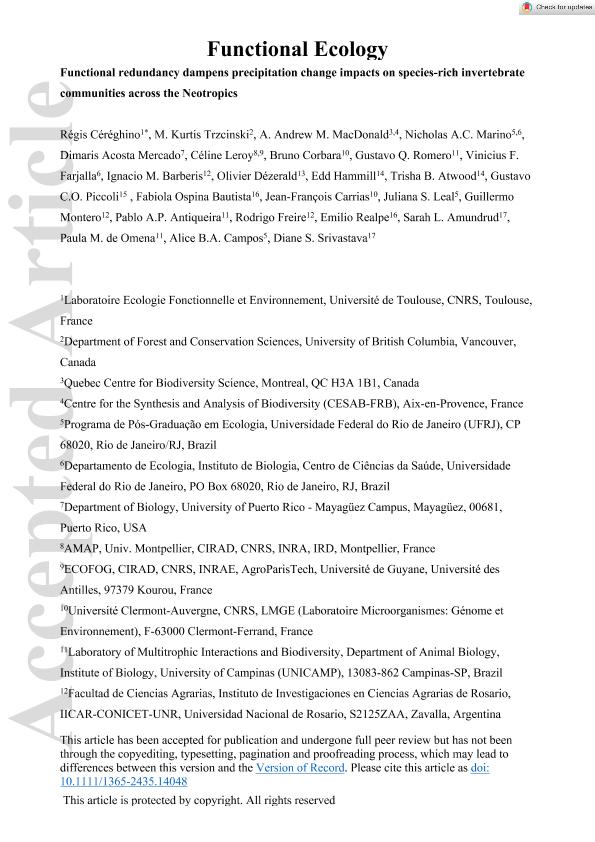Artículo
Functional redundancy dampens precipitation change impacts on species-rich invertebrate communities across the Neotropics
Céréghino, Régis; Trzcinski, Mark Kurtis; MacDonald, A. Andrew M.; Marino, Nicholas A. C.; Acosta Mercado, Dimaris; Leroy, Céline; Corbara, Bruno; Romero, Gustavo Q.; Farjalla, Vinicius F.; Barberis, Ignacio Martín ; Dézerald, Olivier; Hammill, Edd; Atwood, Trisha B.; Piccoli, Gustavo C. O.; Ospina Bautista, Fabiola; Carrias, Jean François; Leal, Juliana S.; Montero, Guillermo Alberto; Antiqueira, Pablo A. P.; Freire, Rodrigo Manuel
; Dézerald, Olivier; Hammill, Edd; Atwood, Trisha B.; Piccoli, Gustavo C. O.; Ospina Bautista, Fabiola; Carrias, Jean François; Leal, Juliana S.; Montero, Guillermo Alberto; Antiqueira, Pablo A. P.; Freire, Rodrigo Manuel ; Realpe, Emilio; Amundrud, Sarah L.; de Omena, Paula M.; Campos, Alice B. A.; Srivastava, Diane S.
; Realpe, Emilio; Amundrud, Sarah L.; de Omena, Paula M.; Campos, Alice B. A.; Srivastava, Diane S.
 ; Dézerald, Olivier; Hammill, Edd; Atwood, Trisha B.; Piccoli, Gustavo C. O.; Ospina Bautista, Fabiola; Carrias, Jean François; Leal, Juliana S.; Montero, Guillermo Alberto; Antiqueira, Pablo A. P.; Freire, Rodrigo Manuel
; Dézerald, Olivier; Hammill, Edd; Atwood, Trisha B.; Piccoli, Gustavo C. O.; Ospina Bautista, Fabiola; Carrias, Jean François; Leal, Juliana S.; Montero, Guillermo Alberto; Antiqueira, Pablo A. P.; Freire, Rodrigo Manuel ; Realpe, Emilio; Amundrud, Sarah L.; de Omena, Paula M.; Campos, Alice B. A.; Srivastava, Diane S.
; Realpe, Emilio; Amundrud, Sarah L.; de Omena, Paula M.; Campos, Alice B. A.; Srivastava, Diane S.
Fecha de publicación:
04/2022
Editorial:
Wiley Blackwell Publishing, Inc
Revista:
Functional Ecology
ISSN:
0269-8463
Idioma:
Inglés
Tipo de recurso:
Artículo publicado
Clasificación temática:
Resumen
Animal community responses to extreme climate events can be predicted from the functional traits represented within communities. However, it is unclear whether geographic variation in the response of functional community structure to climate change is primarily driven by physiological matching to local conditions (local adaptation hypothesis) or by differences between species pools in functional redundancy (insurance hypothesis). We conducted a coordinated experiment to understand how aquatic invertebrate traits mediate the responses of multitrophic communities to changes in the quantity and evenness of rainfall in 180 natural freshwater microcosms (tank bromeliads) distributed across six sites from 18°N in the Caribbean to 29°S in South America. At each site, we manipulated the mean and dispersion of the daily amount of rainfall that entered tank bromeliads over a 2-month period. Manipulations covered a response surface representing 50% to 200% of the dispersion of daily rainfall crossed with 10% to 300% of the mean amounts of rainfall. The response of functional community structure to precipitation regimes differed across sites. These geographic differences were not consistent with the local adaptation hypothesis, as responses did not correlate with the current amplitude in precipitation. Geographic differences in community responses were consistent with the insurance hypothesis: sites with the lowest functional redundancy in their species pools had the strongest response to a gradient in hydrological variability induced by uneven precipitation. In such sites, an increase in the hydrologic variability induced a shift from communities with both pelagic and benthic traits using both green and brown energy channels to strictly benthic, brown energy communities. Our results predict uneven impacts of precipitation change on community structure and energy channels within communities across Neotropical regions. This geographic variation is due more to differences in the size and redundancy of species pools than to local adaptation. Strategies for climate change adaptation should thus seek to identify and preserve functionally unique species and their habitats. Read the free Plain Language Summary for this article on the Journal blog.
Archivos asociados
Licencia
Identificadores
Colecciones
Articulos(IICAR)
Articulos de INST. DE INVESTIGACIONES EN CIENCIAS AGRARIAS DE ROSARIO
Articulos de INST. DE INVESTIGACIONES EN CIENCIAS AGRARIAS DE ROSARIO
Citación
Céréghino, Régis; Trzcinski, Mark Kurtis; MacDonald, A. Andrew M.; Marino, Nicholas A. C.; Acosta Mercado, Dimaris; et al.; Functional redundancy dampens precipitation change impacts on species-rich invertebrate communities across the Neotropics; Wiley Blackwell Publishing, Inc; Functional Ecology; 36; 7; 4-2022; 1559-1572
Compartir
Altmétricas



